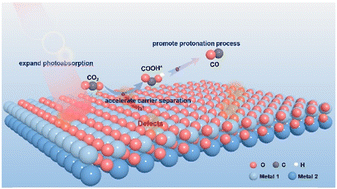Optimized full CO2 photoreduction process by defective spinel atomic layers†
Abstract
The impact of defects on the carbon dioxide (CO2) photoreduction property is sometimes contradictory. Herein, we employ two-dimensional materials, possessing high-density and high-uniformity active sites, as ideal models to thoroughly investigate the influence of defects on three main processes during CO2 photoreduction. As an example, oxygen-deficient ZnGa2O4 atomic layers are successfully fabricated, verified by the electron spin resonance spectra, X-ray photoelectron spectroscopy spectra and X-ray absorption near edge structure spectra. UV-vis diffuse reflectance spectra, photoluminescence spectra, surface photovoltage spectroscopy, N2 adsorption–desorption isotherm plots and density functional theory calculations indicate that the presence of oxygen defects helps to expand the photoabsorption, accelerate the carrier separation, and enhance the CO2 adsorption and protonation process. As a result, the carbon monoxide evolution rate of the defective ZnGa2O4 atomic layers was approximately 88 times higher than that of the ZnGa2O4 atomic layers under visible light irradiation. In other words, this work discloses that the introduction of defects on photocatalysts allows the optimization of the three primary processes, thus obtaining boosted CO2 photoreduction performance.

- This article is part of the themed collection: 2023 Emerging Investigators


 Please wait while we load your content...
Please wait while we load your content...